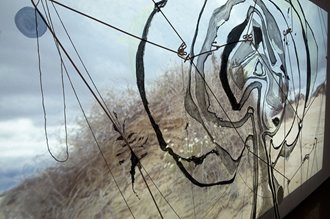 Not My Garden | from Contemplation to Collaboration
Not My Garden | from Contemplation to Collaboration
words by Jonathan Kimberley
Like a hybrid organism, this essay has evolved out of the welcome undoing of my own personal cultural assumptions over time and revised earlier writings. It briefly backgrounds my contribution to the forthcoming Home Town symposium in Perth, November 2017, where I’ll discuss five local <> international projects that I’ve developed as an artist <> curator:
1. Beyond the Global Dome of Thinking with puralia meenamatta - Jim Everett (plangermairrenner, meenamatta country) (ongoing since 2004); 2. Kuluntjarra World Map (The Nine Collaborations) (2008-2010) with Ngipi Ward, Pulpurru Davies, Nancy Carnegie, Manupa Butler, Norma Giles, Jodie Carnegie and Paul Carnegie (Ngaanyatjarra Country). 3. Lena Nyadbi Dayiwul Lirlmim (Barramundi Scales) (2011-2012) (Gija Country) Musée du quay Branly, Paris; 4. Unmapping the End of the World (2014-2015), a collaborative journey by 16 international artists between three UNESCO World Heritage sites in Australia, Japan and Italy; 5. Present by Sasha Huber & Petri Saarikko, GASP (Glenorchy Art & Sculpture Park) (2016-2017), Tasmania.
…None of which I’ve written about here directly, but all of which have emerged out of earlier journeys where I have shifted my approach from contemplation to collaboration. Reflecting on the roving that has both preceded and enabled the evolution of the above projects, I feel that it’s important to pause and recognise where the ideas have come from and that they have all evolved via sustained, durational collaborative journeys, in some cases over many years.
But most importantly, throughout all of these journeys I have been fully cognisant of the fact-reality that local and international recognition of Australia as a continent comprised of more than 200 diverse Aboriginal nations — the equal of any other global nations — is long overdue.
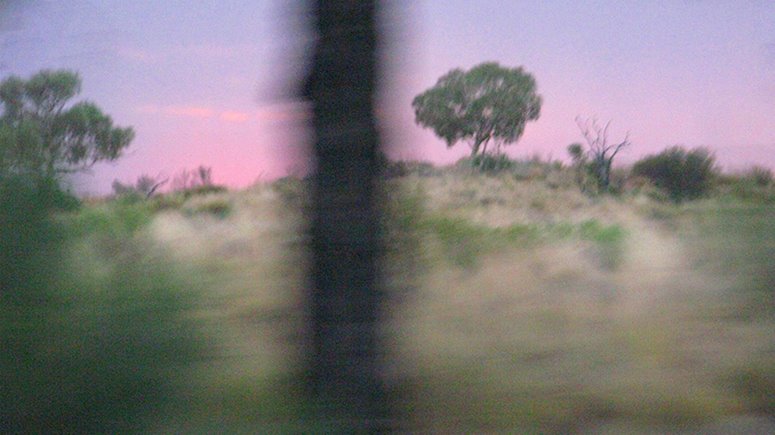
Landscape as present history
'Why didn’t I become an architect? Answer: Because I thought the blank sheets of paper on which I was to pour my dreams were blank. But after twenty-five years of writing, I have come to understand that those pages are never blank. I know very well now that when I sit down at my table, I am sitting with tradition and with those who refuse absolutely to bow to rules or to history; I am sitting with things born of coincidence and disorder, darkness, fear, and dirt, with the past and its ghosts, and all the things that officialdom and our language wish to forget; I am sitting with fear and with the dreams to which fear gives rise …But in those days I was a resolute modernist who wished to escape from the burden, the filth, and the ghost-ridden twilight that was history — and what’s more, I was an optimistic Westernizer, certain that all was going to plan.’ Orhan Pamuk[i]
Historically the propagation of the imported landscape paradigm has been so effective in creating the identity of ‘Australia’ that ‘landscape’ as a word now lacks any meaningful contemporary identity beyond describing presumptions about the persistence of westernising urbanity.
Historically, ‘landscape’ has been delimiting and exclusive. Western conceptions of ‘landscape’ have always been captive of idyllic desires to reduce the complexity of the world, as a claimant act, through narcissism, commodification, or simply to render it more understandable.
Indeed, the trajectory of Western modernism can be tracked almost in parallel with that of the Western concept of landscape. In a paper titled Landscape and the overcoming of Modernity (2000), French philosopher, Augustin Berque makes clear that, ‘Landscape is not a universal object.’[ii] Rather than being universal, the landscape paradigm is historical. It gradually emerged out of the largely forgotten Western idea of the ecumene[iii] (for example pictured in medieval cartography), which it replaced with a more scientific perspectival vision that informed the European Age of Empire (colonialism, now globalism). Arguably this reformulation of the ecumene as the landscape paradigm is continuing to be imagined into being as ‘Australia’ today. It is a contemporary mythical global-village born out of more than a thousand years of dreaming that ‘Westernization’ would inevitably become the global universal.
This enduring landscape paradigm remains one of the most powerful defining and designing agents of the so-called postcolonial era in Australia. It is hidden amidst enduring presumptions that ‘landscape’ in all its guises, from gold gilded frames, to contemporary screen culture of all kinds, to national and state borders, can be reinvented as some kind of benign expression of a post-colonial future.
European conceptions of ’landscape’ are thus arguably the most successful, resilient and subversive agents of identity propaganda of modern times; and particularly resilient in Australia because of the overwhelming temptation by our dominant ‘Westernising’ landscape paradigm for deeply self-referential re-interpretation, despite well-documented potential for the formation of a more reciprocal intercultural placedness.[iv]
This is not my garden
The tough ground-work required to develop and facilitate ambitious, international, site-specific contemporary art projects, which reconfigure outmoded conceptions of ‘landscape’ towards a more substantial intercultural reciprocity, continues to challenge notions of what a ‘home town’, let alone a home country, might mean for many — particularly in Australia.
On the global stage, one can be perceived as being overly earnest and self-conscious to declare cultural diversity as the core program, because it should simply be a given. Yet global intercultural contemporaneity remains a difficult mode of existence to inhabit. I would argue that reconciling the convergence of diverse international artistic traditions that are breaking away from outmoded timelines in meaningful ways, is the central artistic challenge that defines our age. At first glance, ‘displac(ing) the provincialist bind’[v] is inescapable when it comes to Australian projects engaged at the local-global nexus, as Terry Smith and others have articulated.
Yet, as I mention above, the Australian continent has always been international — a unique locus of global contemporaneity in its own right. So what can actually free us from the strangely dominant cultural desire to map our perceived ‘provincial’ limitations, when actually, we all live together within one of the most compelling and diverse ‘local<>international’ continents on the planet?
I argue that making the shift from contemplation to collaboration within the local <> international can lead to successful dissolution of the ‘provincialist bind’.
While Orhan Pamuk’s life experience is entirely different from my own, his intercultural and working experience resonates with me. When I sit down at my ‘table’ as an artist it is not only a table in the room of the writer, or in the studio of a painter, but rather a tabula non-rasa which extends out in the world, into the immense and absolutely un-blank page of the ‘land’ into which I was born.
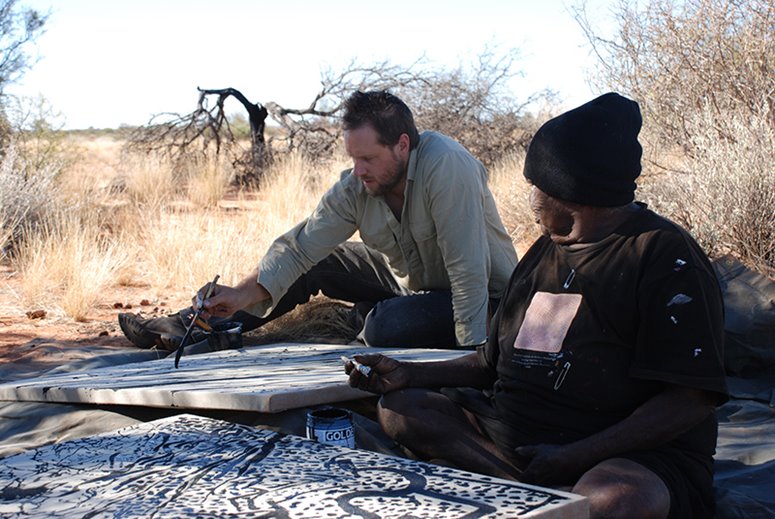
Out of painting
As an artist <> curator I have long worked both ‘out-bush’ and in an urban studio, both collaboratively and individually and with extraordinary people from diverse cultures. And yet, I inevitably continue to sit critically and uncomfortably at the horizon table of Western cultures’ seeming inability to move more reciprocally and productively through the gap between neo-colonial ‘Landscape’ and the full diversity of Aboriginal conceptions of Country and international perspectives more broadly.
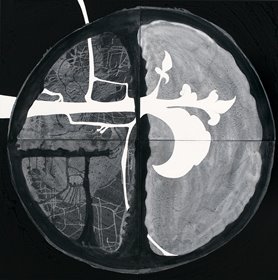 I began to make the shift from contemplation to collaboration in 2001, when I developed a long-term series I called Reconfigured Bush Paintings. These paintings formed part of a deliberate ‘reconfiguration' of both the European tradition of ‘painting en plein air’ and the persistent perspectival ‘ego’ of the overarching landscape paradigm in Australia. Central to my practice has been what writer puralia meenamatta (Jim Everett), with whom I have worked with since 2004, describes as ‘collaboration with country’[vi] — where an integral part of the painting process involves making the work ‘out-bush’ and at times in both formal & informal collaboration with the people whose country I am painting.
I began to make the shift from contemplation to collaboration in 2001, when I developed a long-term series I called Reconfigured Bush Paintings. These paintings formed part of a deliberate ‘reconfiguration' of both the European tradition of ‘painting en plein air’ and the persistent perspectival ‘ego’ of the overarching landscape paradigm in Australia. Central to my practice has been what writer puralia meenamatta (Jim Everett), with whom I have worked with since 2004, describes as ‘collaboration with country’[vi] — where an integral part of the painting process involves making the work ‘out-bush’ and at times in both formal & informal collaboration with the people whose country I am painting.
The four-panels in a square format of these reconfigured bush paintings represents both a conscious and unconscious personal opening up to ‘country’; a metaphorical reconfiguration of the self, enabling and giving rise to what has been called ‘a new point of potential’ [vii].
The four panels are rearranged throughout the painting process, both ‘out bush’ and in the studio, whereby the painting is ‘opened up to country’ (the space between the four panels is literally opened up and the panels dispersed) before being ‘reconfigured’ as an a-perspectival square, representing a shift or break in Western perspectival modernism.
The convergent point at the centre of the reconfigured four panels also references and critiques the ever-present origin and continuing influence of both Brunelleschi’s single-point perspective and the ‘Albertian grid’ as originator icons within the contemporary landscape paradigm. In many collaborative works made with writer puralia meenamatta, a deliberate visual tension exists between the central (perspectival) location of text, and the nature of the text; Jim’s words for country are diaphanous yet indelible, grounded, inclusive, unlandscape. The text is intended to return the perspectival gaze, not in Brunelleschi mirror-like reflection (the single point perspective of the landscape paradigm self), but as collaborative inscriptions articulating the ever-present, reciprocal intercultural discussion.
Present en route
Following my first project with Jim Everett, I began exploring the idea of unlandscape in my work. It seemed obvious that there continued to be a missing non-Aboriginal ‘coexistent’ with landscape in this discussion. In 2007 I exhibited a series called Not My Garden. All the paintings were titled Map of Unlandscape, in reference to what I saw as the potential for new understandings to be drawn from within Western culture, which could enable more reciprocal and productive intercultural discussion. In this context, the idea of unlandscape provided an active and intermediary surfactant between ‘landscape’ and ‘Country’, a way of re-assessing the Western landscape trajectory amidst shifting inter-cultural understandings of old country in new time.
Rather than redefine the word ‘landscape’ in order for it to accommodate the postcolonial imperative, I proposed the term unlandscape to describe that which is not necessarily bound by the landscape paradigm, but which is coexistent with, and critically aware of, landscape’s inherent (western) cultural limitations. At the same time unlandscape is ironic in that it is at least as unlikely to actually occur as the postcolonial. However, perhaps the working idea of unlandscape might provide an avenue for investigations into a historical review and more open and reciprocal contemporary conception of Euro-Australian culture.
Homi Bhabha writes,
The time-lag of postcolonial modernity moves forward, erasing that compliant past tethered to the myth of progress, ordered in the binarisms of its cultural logic: past/present, inside/outside…It is the function of the lag to slow down the linear, progressive time of modernity to reveal its ‘gesture’, its tempi, ‘the pauses and stresses of the whole performance’. This slowing down, or lagging, impels the ‘past’, projects it, gives its ‘dead’ symbols the circulatory life of the ‘sign’ of the present, of passage, the quickening of the quotidian,’[viii]
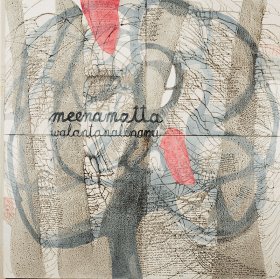 I thought, perhaps it was the ‘time-lag’ of unlandscape which could provide the agency required to move through the neo-colonial gaze of Australia to a more globally resonant conception of who we are?
I thought, perhaps it was the ‘time-lag’ of unlandscape which could provide the agency required to move through the neo-colonial gaze of Australia to a more globally resonant conception of who we are?
As a pure-blood-whitefella of First Fleet convict (English) descent, my sense of home is at once grounded in adaptation and is ambivalent towards the new ghosts of post-colonialism. I live amidst the inherently beautiful complexity and multi-nation ‘fact-reality’[ix] of the continent of Australia that comprises many Aboriginal Countries, as well as being one of the most globally diverse places on earth. Any perceived ‘time-lag’ is quite simply — the present. This continues to inform all of my work as an artist <> curator, which my presentation for Home Town will elucidate.
Not binary but protean, this Country is not my garden; nor can I claim that the propagation of the landscape paradigm is not my garden.
Jonathan Kimberley is an artist, senior curator and writer based in Tasmania, Australia, where he is director of GASP (Glenorchy Art & Sculpture Park). He has curated more than 50 exhibitions and participated in 60 exhibitions as an interdisciplinary artist throughout Australia and internationally.
Home Town
Artist and community ambition on an international stage
An Artsource and UWA symposium
For more information about this event, click here >
[i] Pamuk, Orhan, ‘Why Didn’t I Become an Architect?’ In Other Colours, Essays and a Story, New York: Alfred A Knopf, Random House, 2007, p.307.
[ii] Augustin Berque. ‘Landscape and the overcoming of modernity - Zong Bing’s principle.’ The Cultural Approach In Geography, EHESS/CNRS, Paris & Miyagi University, Sendai, Seoul, August 14-18, 2000, p. 1.
[iii] The word ECUMÉNE (also, oikoumene) comes from the Greek noun ‘oikos’ (home) and the Greek verb ‘meni’ (to live), hence the ecumene is ‘the home of all that have life,’ a philosophical state of being that includes those who lived in the past, who live in the present, and may live in the future.
[iv] Kimberley, Jonathan, Country Unwrapping Landscape | Kuluntjarra World Map (and the nine collaborations), 2010, MFA thesis, University of Western Australia.
[v] Smith, Terry, ArtMargins Feb, 2017 p.32.
[vi] Everett, Jim, Keeping Culture: Aboriginal Tasmania, Australian National Museum, 2006.
[vii] Izett, Erica, ‘Sitting Down with Indigenous Artists – New perspectives in Kardiya art’, Artlink, 25 2, 2005.
[viii] Bhabha, Homi K, The Location of Culture, Routledge, New York, 1994. p. 246.
[ix] Letter from Jim Everett to the author and Ian McLean,16th March 2007.
Images (top to bottom):
-
Jonathan Kimberley & Koji Ryui, Axis Mundi | Mungo Labyrinth (Unmapping the End of the World) 2015, Installation (detail) HD video, wall drawing, poly-coated wire, string, found objects, Mildura Palimpsest Biennale #10 2015.
-
Jonathan Kimberley, After Disurbanity (A fast drive in an HJ60) 2008, HD video (still), Gibson Desert WA. Image courtesy of the artist.
-
Jonathan Kimberley & Pulpurru Davies, Kuluntjarra World Map 2008, first lake camp, Gibson Desert WA. Photographer: Mike Stitfold.
-
Jonathan Kimberley, Not My Garden (Map of Unlandscape) 2007, Charcoal, acrylic, ink on linen 180 x 180 cm (four panels). Image courtesy of the artist.
-
Jonathan Kimberley & Jim Everett, meenamatta walantanalinany - beyond the colonial construct, 2006, Handwritten text, acrylic & charcoal on linen, 240 x 240 cm (four panels).